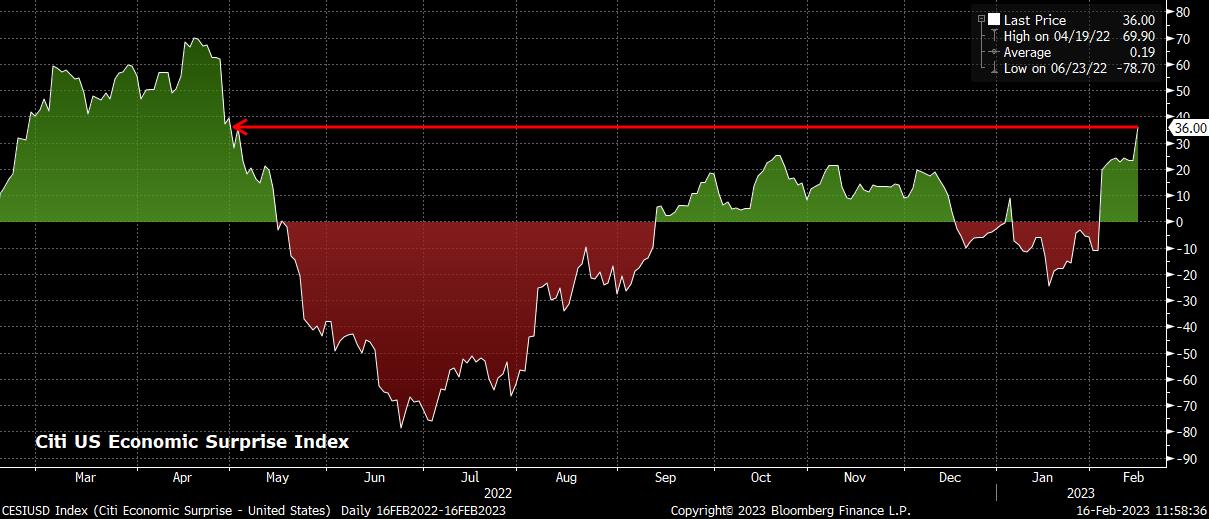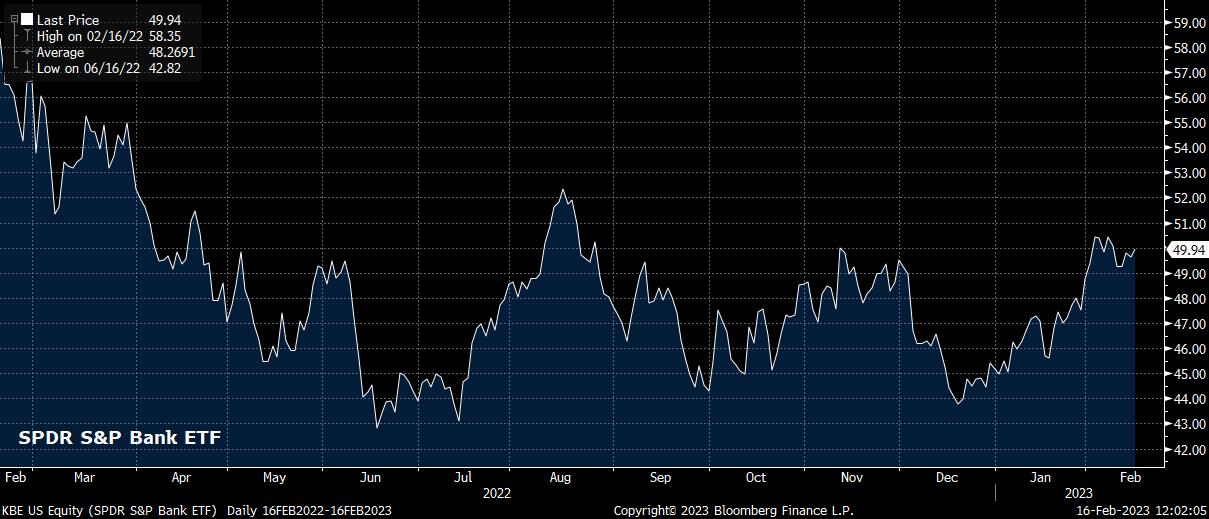Hard Landing Turns to Soft Landing
Since the blowout labour market report at the start of February, and impressively strong ISM services PMI print which dropped on the same day, economic releases have consistently, and by a considerable margin, been surprising to the upside compared to consensus expectations. Citi’s economic surprise index, which sits at its highest since last October, evidences this nicely.

Clearly, hotter than anticipated labour market figures, upbeat retail sales, a continued decline in inflation, and resilient activity stats, have all led to investors tearing up the playbooks that they had written coming into the year. Not only that, traders are also starting to view Fedspeak through a different lens; having spent months ignoring what the Fed were saying about rates going ‘higher for longer’, markets have suddenly started to believe the rhetoric.
The reason for this sudden shift has little to do with the Fed itself, in which the market appears to continue to lack confidence, but more to do with data now reinforcing the Fed’s ‘soft landing’ viewpoint. We had pondered for some time what would make markets ‘wake up and smell the coffee’ in terms of the policy outlook, and now we have our answer.
Nevertheless, while the terminal rate may now be accurately priced – according to the Fed’s dot plot, at least – just above 5.25%, we continue to see markets expecting a full 25bps cut in the second half of the year. This, clearly, runs contrary to the FOMC’s recent remarks, though one could argue that current market pricing is more a reflection of growth risks being tilted to the downside, and the balance of probabilities leaning towards a cut by year-end, instead of an outright expectation that policy will be loosened in that time period. Either way, the curve has seen a hawkish repricing over the last fortnight, implying the market is becoming more bullish on the US economy’s prospects.

Of course, the key question in all of this is how to trade it?
Equities, are, probably, the best place to start when considering this question, though the outlook is far from clear, with the bulls spurred on by stronger than expected data, but the bears waiting to pounce on the fact that the better the data, the higher rates are likely to head, and the longer they are likely to stay there. The tug-of-war between these two factors, which has yet to produce a decisive winner, is likely a significant factor behind the consolidation that we have seen of late.
In such an environment, where the market is becoming increasingly optimistic on the prospects of a ‘soft landing’ being achieved, a sector-specific approach makes considerably more sense. Those stocks which are likely to benefit from an improving economic outlook, while being able to shrug off continued Fed hawkishness. Financials are one that immediately spring to mind, with the sector +7% YTD, and standing to benefit as Treasuries reprice in a more hawkish direction; the S&P banks ETF (ticker – KBE), is one way to get exposure to this theme.

One must also consider sectors that may face headwinds. Tech may be an obvious laggard in a world where rates rise to a greater degree than markets expect, though has proved relatively resilient thus far. Instead, it may be worth considering that last year’s winners, could become this year’s losers, with sectors such as energy and utilities starting to face headwinds, as they have already done so in the early part of the year.
In the Treasury market, we would expect the sell-off that has gripped the market of late to persist, with the market continuing its hawkish Fed repricing. Clearly, the front end of the curve is likely to bear brunt of any such move, as it has done already, furthering the curve inversion, which is already at its deepest since the early-80s.

Higher front-end yields should prove to be good news for the greenback, though it has been interest to see how the USD appears to require a continual stream of good news in order to gain ground. Almost as if the bulls require constant reassurance that they are taking the correct position. Given the dearth of top-tier releases between now and the next payrolls print on 10th March, this may pose a problem.
Nevertheless, despite this, the classic inverse correlation between the JPY and Treasury yields holds firm; and, in fact, the link between the 2-year and USDJPY is at its tightest since last November. The JPY doesn’t appear to have especially much going for it right now, especially with hopes of a significant hawkish shift from the BoJ having been dented after new Governor Ueda’s initial comments pointed to broad alignment with the current policy stance.

It’s also worth noting that there tends to be a strong seasonal effect in USDJPY at this time of year. Typically, seasonal patterns should be taken with a pinch of salt, as they are often a product of randomness rather than having any sort of underlying rationale. This case, however, is slightly different, with the JPY softness coming into the end of the Japanese fiscal year, hence meaning that this seasonal trend is likely to be built on more solid foundations than most others.
Related articles
The material provided here has not been prepared in accordance with legal requirements designed to promote the independence of investment research and as such is considered to be a marketing communication. Whilst it is not subject to any prohibition on dealing ahead of the dissemination of investment research we will not seek to take any advantage before providing it to our clients.
Pepperstone doesn’t represent that the material provided here is accurate, current or complete, and therefore shouldn’t be relied upon as such. The information, whether from a third party or not, isn’t to be considered as a recommendation; or an offer to buy or sell; or the solicitation of an offer to buy or sell any security, financial product or instrument; or to participate in any particular trading strategy. It does not take into account readers’ financial situation or investment objectives. We advise any readers of this content to seek their own advice. Without the approval of Pepperstone, reproduction or redistribution of this information isn’t permitted.

